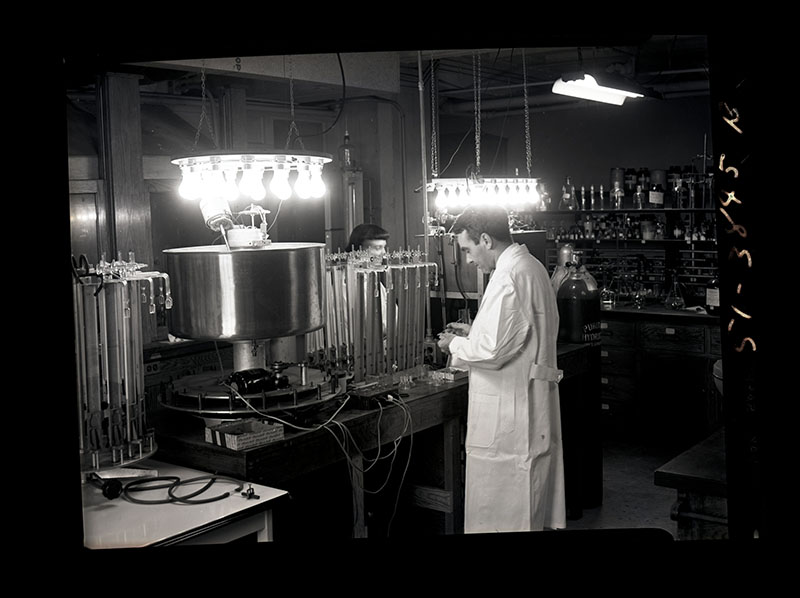This is the second installment in an ongoing series on Martin Kamen. Read the first installment here.

There was every prospect of a brilliant career for me in isotopic tracer methodology, a tool crucial in developments that would eventually usher in the era of molecular biology, bringing with it an understanding of the molecular basis of genetics and elucidation of metabolic pathways in living systems. At Washington University there was a medical school faculty of scientific stature unsurpassed anywhere in the country. (Kamen, Dark Politics, Radiant Science: memoir of the nuclear age, 1985, p. 187)

Martin Kamen told the story of his career at Washington University beautifully in his 1985 memoir, “Dark Politics, Radiant Science: memoir of the nuclear age.” Physicist Arthur Hughes, an expert on X-rays who was a consulting physicist to the radiology department, took him in hand when he arrived at Washington University in April 1945 (Kamen, 1985, p. 188). Hughes showed him around the 80-inch cyclotron that was used for medical research and introduced him to faculty and staff.
The cyclotron and mass spectrometer were key to a postwar medical research program that used isotopic tracers. A cyclotron could produce radioisotopes like radiophosphorus (P32) and carbon 14, but Hughes and Kamen agreed that a tracer program needed stable isotopes such as nitrogen-15 and Carbon-13 (Kamen, Dark Politics, Radiant Science: memoir of the nuclear age, 1985, pp. 191-192).
The Cyclotron in Peacetime: Radioisotopes for medical research
Washington University’s new chancellor, Arthur H. Compton, had hired Kamen to increase the production of radioactive phosphorus (P32) (O’Connor, Imaging & innovation: a history of Mallinckrodt Institute of Radiology, 2013, p. 54), a promising radiation treatment for leukemia and other cancers. A massive clinical trial on radiophosphorus was led by Edward Reinhard, and was one of many clinical research studies awaiting Kamen’s arrival. Kamen had prior experience as the chemist on pioneering studies on radiation treatments at Berkeley in the 1930s. As the chemist for radiophosphorus clinical trials at Washington University, Kamen’s role was similar. He calibrated the dosage using assays, allowing the clinicians to compare their treatment findings with early and current literature. Kamen spent much of his first year on assay calibration of radiophosphorus and he wrote a three-page appendix recording his methods for the definitive 1946 monograph “Radioactive phosphorus as a therapeutic agent.”
A new mass spectrometer produces stable isotopes
Kamen and Hughes, who also headed the physics department, investigated the possibility of building a mass spectrometer to generate rare stable isotopes. Moreover, they traveled together to facilities at McMaster University and University of Iowa to troubleshoot the mass spectrometer that they built (Kamen, Dark Politics, Radiant Science: memoir of the nuclear age, 1985, pp. 192-193). One early collaboration in basic research using Nitrogen-15, a stable isotope, was due to the interest of physician Carl V. Moore, MD, in blood diseases. Moises Grinstein, an Argentinian expert in porphyrin chemistry, asked Kamen if it was possible to label the “heme” group in hemoglobin so researchers could follow that metabolism of blood in normal and diseased patients suffering from various anemias. A series of scientific papers by Grinstein, Moore & Kamen resulted. (Kamen, Dark Politics, Radiant Science: memoir of the nuclear age, 1985, pp. 190-191). (Grinstein, 1950).

Sources
Eaton, P. (1946, August 3). 4 St. Louis institutions ask for 11 atomic medical Units. St. Louis Star-Times, p. 1.
Grinstein, M. K. (1950). Isotopic Studies of Porphyrin and Hemoglobin Metabolism. J. biol. Chem., 182, 715.
Hughes, Arthur L. Vertical File. (n.d.). Bernard Becker Medical Archives, Washington University in St. Louis.
Kamen, M. D. (1957, third edition). Isotopic tracers in biology: an introduction to tracer Methodology. New York: Academic Press Inc., Publishers.
Kamen, M. D. (1985). Dark Politics, Radiant Science: memoir of the nuclear age. Berkeley: University of California Press. Retrieved April 26, 2019, from http://catalog.wustl.edu/search/o9830883 ; https://books.google.com/books?id=jcV4r2Idqf0C&lpg=PP1&dq=Martin%20Kamen&pg=PP1#v=onepage&q=Martin%20Kamen&f=false
Kamen, M. D. (1986). A cupful of luck, a pinch of sagacity. Ann. Rev. Biochem, 55, 1-44. Retrieved April 23, 2019, from https://www.annualreviews.org/doi/pdf/10.1146/annurev.bi.55.070186.000245
Martin Kamen and Herta Bregoff in Laboratory, 3 views, 1951. (1951). Washington University School of Medicine Department of Medical Illustration Negatives, VC246-51-3845, VC246-51-3845A-B.
O’Connor, C. (2003). Beginning a great work. St. Louis: Washington University in St. Louis. Retrieved from https://books.google.com/books?id=tnksAQAAIAAJ&q=%22Carol+Skinner+Cole%22&dq=%22Carol+Skinner+Cole%22&hl=en&sa=X&ved=0ahUKEwj93-vq9dndAhWj64MKHYW2AQcQ6AEIPzAE
O’Connor, C. (2013). Imaging & innovation: a history of Mallinckrodt Institute of Radiology. Saint Louis: Mallinckrodt Institute of Radiology, Washington University.
Reinhard, E. H., & w. a. (February 1946). Radioactive phosphorus as a therapeutic agent: a review of the literature and analysis of the results of treatment of 155 patients with various blood dyscrasias, lymphomas, and other malignant neoplastic diseases. Reprint from the Journal of Laboratory and Clinical Medicine, 31(2), 107-210. doi:ht
Washington University School of Medicine Bulletin. (1948). Saint Louis: Washington University. Retrieved from https://digitalcommons.wustl.edu/med_bulletins/49/
Washington University School of Medicine Bulletin, 1946. (1946). Retrieved from Digital Commons@Becker: https://digitalcommons.wustl.edu/med_bulletins/47/
